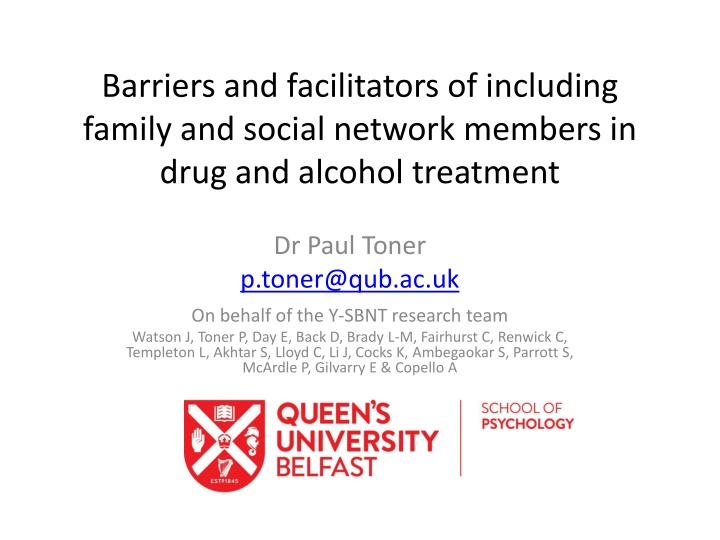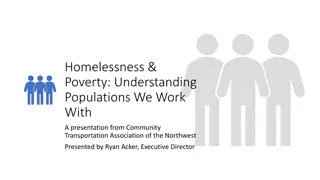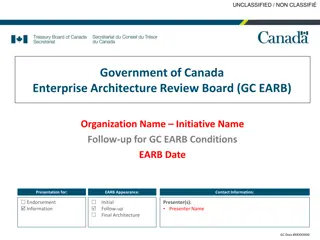
Inclusion of Family in Drug and Alcohol Treatment: Research Insights
Explore barriers and facilitators of involving family and social network members in drug and alcohol treatment. This qualitative study examines the feasibility and acceptability of a family-based intervention among young people with substance use issues. Discover key findings on the impact of the adapted intervention and potential modifications needed for effective treatment.
Download Presentation

Please find below an Image/Link to download the presentation.
The content on the website is provided AS IS for your information and personal use only. It may not be sold, licensed, or shared on other websites without obtaining consent from the author. If you encounter any issues during the download, it is possible that the publisher has removed the file from their server.
You are allowed to download the files provided on this website for personal or commercial use, subject to the condition that they are used lawfully. All files are the property of their respective owners.
The content on the website is provided AS IS for your information and personal use only. It may not be sold, licensed, or shared on other websites without obtaining consent from the author.
E N D
Presentation Transcript
Barriers and facilitators of including family and social network members in drug and alcohol treatment Dr Paul Toner p.toner@qub.ac.uk On behalf of the Y-SBNT research team Watson J, Toner P, Day E, Back D, Brady L-M, Fairhurst C, Renwick C, Templeton L, Akhtar S, Lloyd C, Li J, Cocks K, Ambegaokar S, Parrott S, McArdle P, Gilvarry E & Copello A
Study Aims Overall Demonstrate the feasibility of recruiting young people to a specifically developed family and wider social network- based intervention by testing an adapted version of adult social behaviour and network therapy (SBNT) Qualitative Explore the acceptability of the Y-SBNT intervention to the young people and the wider context of impact Identify ways in which Y-SBNT may need to be modified
Overall Approach A pragmatic, two-armed randomised controlled open feasibility trial, based in two UK-based treatment services 53 young people aged 12-18 years, newly referred and accepted for structured interventions for drug and/or alcohol problems, were recruited and randomised to receive either the adapted Y-SBNT intervention or treatment as usual
Qualitative Approach Twenty five semi-structured interviews were conducted 3 months post randomisation with young people (17) and network members (2) and therapists (5)/service manager (1) were interviewed at a single time point towards the end of the study Thematic analysis1was used to analyse the data 1. Braun V, Clarke V. Using thematic analysis in psychology. Qual Res Psychol 2006;3:77 101.
Qualitative Findings Young people, network members, therapists and a service manager found the new treatment approach acceptable to them YP: The majority of young people did not perceive their substance use as a problem on entering treatment nor did their friends, who also tended to use YP referred from the youth offending system were ambivalent about changing their substance use and perceived Y-SBNT as compulsory probation meetings
Qualitative Findings Other YP who engaged with and were exposed to the active components of Y-SBNT reported positive benefits such as strengthening relationships and network member involvement in non-using activities They appreciated that treatment goals did not have to be specific to their substance use or abstinence focused
Family and Social Network Members Only two network members (mother and teacher) were interviewed, both from the North East, which perhaps reflects a lack of network member engagement Involvement was more peripheral and supportive in nature rather than carrying out agreed actions discussed in treatment When actions were mentioned these tended to be more practical Despite this, network members perceived positive changes for the young people in terms of better communication and strengthening relationships
Family and Social Network Approach The therapists saw great merit in taking a wider network approach in helping to support the young people beyond their treatment sessions Therapists in the North East felt that the new treatment worked best when they were able to facilitate alignment of the young person s treatment goals with those of their support network
Family and Social Network Approach There were issues with treatment implementation, particularly in the West Midlands service. This was largely because of a service retendering process causing staff upheaval during the study Therapists in both services mentioned practical and logistical restraints that made it difficult to have network members attend sessions
Family and Social Network Approach As a treatment approach the service manager spoke in glowing terms about Y-SBNT - having the whole network effectively becoming the client should be fundamental to how services work and had wider applicability However, in the current study, social networks were not fully engaged with goal setting and there was an over- reliance on professional supporters They suggested that Y-SBNT could work better as an early intervention when more natural networks existed






















